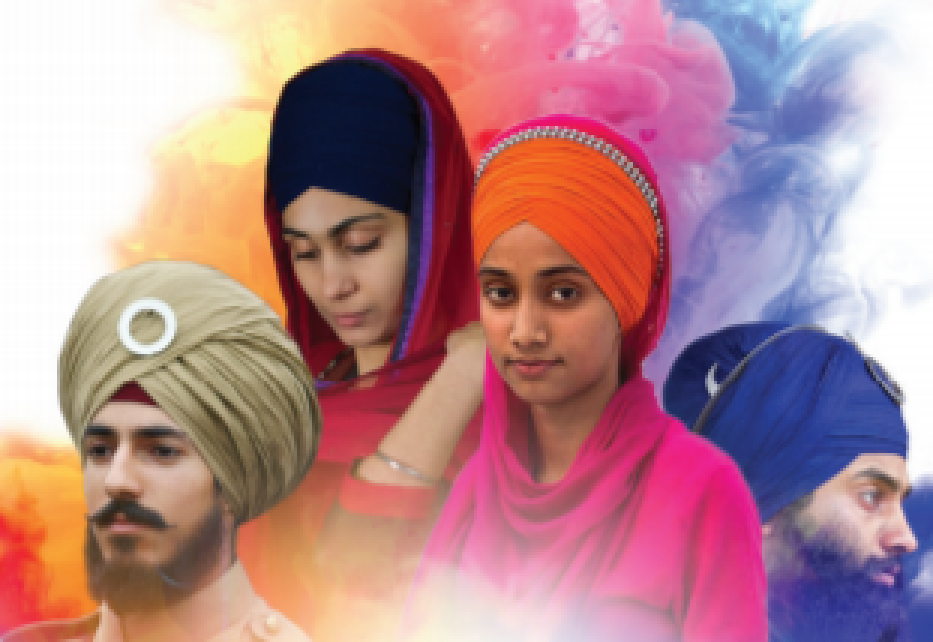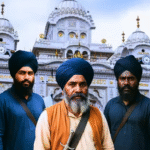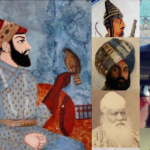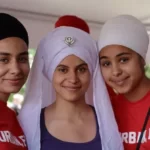Dastār (Punjabi: دستار/دستار, from Persian: دستار; dast or “hand” with the suffix -ār)[1] is an item of headgear associated with Sikhism and an important part of the Sikh culture. The word is borrowed from Persian via Punjabi. In Persian, the word dastār can refer to any kind of turban and has replaced the original word for turban, dolband (دلبند), from which the English word is derived.
Among Sikhs, the dastār is an article of faith that represents equality, honor, self-respect, courage, spirituality, and piety. Khalsa Sikh men and women who hold the Five Ks wear a turban to cover their long, uncut hair (kesh). Sikhs consider the dastār to be an important part of the unique Sikh identity. After the ninth Sikh Guru, Tegh Bahadur was sentenced to death by the Mughal Emperor Aurangzeb, Guru Gobind Singh, the tenth Sikh Guru created the Khalsa and gave the five articles of faith, one of which is uncut hair, which the dastār covers.[2]
History
The dastār has been an important part of the Sikh religion since the time of the first Guru, Guru Nanak, who honored Guru Amar Das with a special dastār when he was declared the next Guru. When Guru Ram Das died, Guru Arjan was honored with the dastār of Guruship.
Marne di pag Pirthiye badhi. Guriyaee pag Arjan Ladhi[3]
Guru Gobind Singh, the last human Sikh Guru, wrote:
Kangha dono vaqt kar, paag chune kar bandhai. (“Comb your hair twice a day and carefully tie your turban alternately.”)
Bhai Rattan Singh Bhangu, one of the earliest Sikh historians, wrote in Sri Gur Panth Parkash:
Doi vele utth bandhyo dastare, Pahar aatth rakhyo shastra sambhare
Kesan ki kijo pritpal, nah(i) ustran se katyo waal
Tie dastār twice a day and wear shaster (arms for dharma protection) and keep them with care, 24 hours a day.
Take good care of your hair. Do not cut your hair with a blade.
Importance
Nihang Abchal Nagar (Nihangs of Hazur Sahib), 1844. Shows turbaned Sikh soldiers with chakras.
In Khalsa society, the turban signifies many virtues:
Equality
Sikh society is egalitarian and without gender, religion, race, nationality, or sexual orientation. The Khalsa institution was founded on “Aape Gur Chela”, no master, no slave.
Spirituality
Dastār is a symbol of spirituality, holiness, and humility in Sikhism.
Honor and self-respect
Dastār is also a symbol of honor and self-respect. In Punjabi culture, those who have selflessly served the community are traditionally honored with turbans.
Piety and moral values
Dastār also means piety and purity of mind. In Punjabi society, Khalsa Sikhs are seen as protectors of the weak, even among non-Sikhs. In older times, Khalsa warriors moved from village to village at night, during battles. When they needed to hide from the enemy, women who trusted them very much would let them into their homes. In Punjab it was common to say: Aye Nihang, booha khol de nishang (“The nihangs are at the door. Dear woman! go ahead and open the door without any fear.”)
Courage
Sikhs wear the dastār to cover their long hair, which is never cut as ordered by their previous Guru, Guru Gobind Singh. Many references in Sikh history describe how Guru Gobind Singh personally tied dumals (dastār) on the heads of his two elder sons Ajit Singh and Jujhar Singh and personally gave them weapons, decorated them as grooms, and sent them away. to the battlefield at Chamkaur Sahib, where both died as martyrs. The blue-colored turban is particularly identified with courage, sacrifice, and martyrdom.
Friendship and relationship
Pag Vatauni (“turban exchange”) is a Punjabi custom in which men exchange dastārs with their closest friends. Once they exchange turbans, they become lifelong friends and form lasting relationships. They solemnly pledge to share their joys and sorrows under all circumstances. A turban exchange is a glue that can bind two individuals or families together for generations.
Saying
Many Punjabi idioms and proverbs describe how important dastār is in one’s life. Bhai Gurdas writes:
Tthande khuhu naike pag visar(i) aya sir(i) nangai
Ghar vich ranna(n) kamlia(n) dhussi liti dekh(i) kudhange
(“A man who bathed at a well in winter forgot his dastār at the well and returned home bald.
When the women saw him at home without a dastār, they thought that someone had died and began to cry.)
Uniform of Sikhism
Sikhs are easily recognized by their distinctive turbans, as well as by other articles of faith.
Dastār is considered an integral part of the unique Sikh identity. A bare head is not considered appropriate as in Gurbani. If a Sikh wants to become one with his guru, he must look like a guru (wear a dastār). Guru Gobind Singh stated:
Khalsa mero roop hai khaas. Khalse me hau karo niwas.
(“The Khalsa is my true image. I live in the Khalsa.”)
Keeping one’s hair long and tying the dastār is considered a sign of love, obedience to the wishes of the Sikh Gurus, and acceptance of the Will of God. Quote from Sikhnet:
Dastār is our Guru’s gift to us. Thus we crown ourselves as Singhs and Kaurs who sit on the throne of devotion to our higher consciousness. For both men and women, this projective identity conveys royalty, grace, and uniqueness. It is a signal to others that we live up to the image of the Infinite and are committed to serving all. A turban represents nothing but total commitment. When you choose to stand out by tying your dastār, you stand fearlessly as one single person standing out from six billion people. It is a remarkable feat.
Styles of dastārs
This section needs additional citations for verification. Please help improve this article by adding citations to reliable sources. Unsourced material may be attacked and removed.
This is a very common style of Sikh Turban and is most common in the Indian state of Punjab, India. Nok is a double-width Dastar. Six meters of dastar cloth are cut in half and then into two or three-meter pieces. They are sewn to be twice as wide.








